A Horror-Movie Imagination: The Old Dark House We Lived In
Introduction
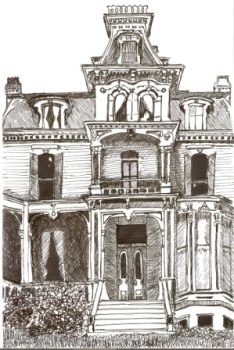 My frame of reference is at least partly informed by years of being entertained by horror stories and films. Frame of reference shapes expectation, and expectation influences perception. In other words, if you’re a horror fan, you may feel a little twinge of nervous anticipation every time you go alone into the basement. You’re primed for it.
My frame of reference is at least partly informed by years of being entertained by horror stories and films. Frame of reference shapes expectation, and expectation influences perception. In other words, if you’re a horror fan, you may feel a little twinge of nervous anticipation every time you go alone into the basement. You’re primed for it.
Even if you don’t for one second think that anything is actually lurking down there more frightening than a basket of laundry or a bit of black mold (which actually can be pretty scary, health-wise: not good to breathe that stuff), it’s just that you’ve seen so many artful and artless portrayals of What. Might. Be. Down. There… You get that twinge, a frisson that can be quite delightful, given that you know there’s no real bogeyman waiting to pounce from behind the furnace, just the thrill of imagining there is one. Which is why you’re a horror fan.
I am a storyteller, yes. Sometimes I write horror stories, and I am an aficionado of the genre: guilty as charged. But everything I recount in the following pages really happened. I have restrained myself from the storyteller’s natural tendency to exaggerate for the sake of effect. In this case, the facts are arresting enough without embellishment. My aim is simply to reconstruct some of the thoughts and impressions that went through my head at the time, thoughts and impressions colored by a horror-movie imagination. This may thereby serve to illustrate how one’s perspective can shape perception.
Some of what follows may seem a bit strange. But if you doubt any of it, just ask my ex: it might have gotten weird at times, but to the best of my memory it all happened. (Except for the part where she claims I screamed like a little girl. Take that with a grain of salt. When I am startled, I tend to think of my vocalization as a deep, throaty, manly yell.)
1 . Isolation
Not long after we moved to Minnesota, my then-wife Joy and I lived for a while in a rather interesting old house in the middle of nowhere. I say “interesting.” Some of you might have used other terms, like creepy, spooky, or f***ed up.
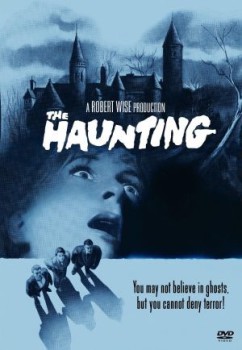 The fact of being out of the way, off the beaten path, and I mean really out in the boonies is a prerequisite for horror-film settings like The Texas Chainsaw Massacre and The Hills Have Eyes and The Haunting and any other film where it’s no use running away from the place because there’s nowhere to run to. So, isolated? Check.
The fact of being out of the way, off the beaten path, and I mean really out in the boonies is a prerequisite for horror-film settings like The Texas Chainsaw Massacre and The Hills Have Eyes and The Haunting and any other film where it’s no use running away from the place because there’s nowhere to run to. So, isolated? Check.
Our decrepit domicile was several miles from the nearest town, which, according to the bullet-riddled town sign, had a population of around 30, if I remember correctly — and when I just went online to double-check that figure, I read the intriguing note that the town “has not been included in past Census counts, so there is no population information for this community.” Now there’s a sentence that would make Lovecraft grin. That town was several miles further still from the nearest settlement large enough that you might expect to get a cell phone signal (this was a few years before cell phones came into wide use, anyway — I wouldn’t own one for another six years). If you wanted a convenience like a gas station or a grocery store, you were in for at least a 16-mile drive.
The farmhouse was a couple miles down an unnamed dirt road that branched off another dirt road that branched off a paved but pockmarked, crumbling road, which you might find yourself driving down if you were hopelessly lost. Each night that we came home from work, it was a marvel that we found it again.
2. The Farm
We rented it from a farmer who raised beef cattle. Its nearest neighbors were at least a half-mile down the road, the next farm over. The house sat on the edge of a deep, thickly wooded valley and was surrounded by pastures divided by wire fences. We would wake in the morning to cattle grazing not ten yards from our bedroom window.
The surrounding pastureland, had it been absent cattle, could easily have been mistaken for a great, sprawling junkyard encompassing several acres. There were scores of cars and trucks parked haphazardly and left to die everywhere you turned. The variety of years, makes, and models was staggering. You’d spot a Geo Metro rusting away next to a Ford Bronco next to a long, boxy ‘70s Cadillac.
The vehicles were sort of like deepening layers of geological strata, in that the farther away from the house you roamed, the older they got. Way out at the far end of the back pasture, just before the land dipped steeply to the valley below, sat a lone, rusted hunk that only retained the basic contours of the original automobile: a monument to early petrol-based travel. I couldn’t tell you the model, only that it had to have been from the ‘20s or ‘30s.
And this detail of the cars was the first catalyst that began to rev up my horror-movie imagination. Where did all these cars come from? They surely hadn’t all been the farmer’s, unless he’d gone through about a vehicle a month through most of his life. Where, then, were the original owners? If this were a horror movie, you know where that line of thought is heading…
3. The Countryside
In the warm months I would go for long walks out in the woods, through acres of wildflowers and pockets of deciduous forest, seeing no other human being for hours. One of my routes would take me by a clearing about a quarter mile from the house on which sat a lone mobile home.
It was just dumped out there, and of course the horror-movie imagination stirred whenever I saw it. Enough so that on a couple occasions I did make a little detour to go peer in its windows. It looked like it had been suddenly abandoned — through the streaked, dirty glass I saw bowls and silverware strewn about the counter, an overturned box of moldering Corn Flakes on the floor. I could not see back into the bedroom (What might be back there? A body?), but my curiosity was not quite strong enough to prod me into opening the door and going inside.
I came close, but I nervously observed that the trailer listed a bit, unbalanced by the grade of the ground as it dipped toward the valley, and I imagined my weight on the doorstep tipping the whole thing over and causing it to roll (and shaking me like dice along with the bowls and Corn Flakes and the dried corpse dislodged from its place of long concealment).
4. The Farmer in the Dell
On the property out back of the farmhouse were more than a half-dozen sheds, barns, and other outbuildings in various states of dilapidation and all of them full to the rafters with stuff — those American Pickers guys would have had a field day exploring this place! The farmer was obviously a hoarder.
A short, lean Norwegian fellow in his fifties who was widowed or divorced (I don’t recall which), he lived in a trailer on the other side of the driveway beside the house. The farmhouse was the family home where he’d grown up — more room, he said, than he needed now, so he rented it out (to the unsuspecting?). Thus it was our luck to call one of the oldest houses in the region, for a time, home.
5. The House
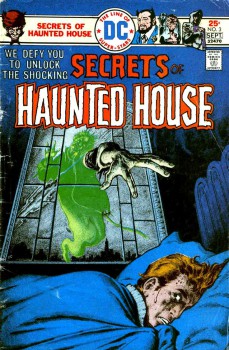 How old was the house? The two-story home, according to the farmer, was originally a stop on a stagecoach route that ran down to the nearest city, Winona, located on the Mississippi River. The outhouse — which the farmer remembered using as a kid — still stood out back, although fortunately plumbing had been installed at some point in the intervening years.
How old was the house? The two-story home, according to the farmer, was originally a stop on a stagecoach route that ran down to the nearest city, Winona, located on the Mississippi River. The outhouse — which the farmer remembered using as a kid — still stood out back, although fortunately plumbing had been installed at some point in the intervening years.
He also informed us that it was the first house in the area to get electricity: and I’m pretty sure it was still those original wires that now powered our computer and TV and all the rest. The wiring was certainly years — decades — out of code. And fire hazard, you wonder? There was an outlet on the wall in the dining room that had singe marks, the wallpaper blackened all around it. I made a mental note not to use that outlet.
Let me set the scene of the house itself, and then we’ll get to the odd and increasingly unsettling discoveries we made as the weeks passed. It was a typical Minnesota wood-frame farmhouse of the late 1800s, with one bedroom downstairs (where we slept) and two upstairs. There was a downstairs bathroom, a dining room, a living room, and a kitchen. The kitchen was a bit of an “add-on,” in that it had originally been the back porch, which at some point had been closed in and modernized. There was also a closed-in porch along the front of the house — what you might call a three-season room, although it was so full of the farmer’s junk (did I mention he was a hoarder?) that in no season did we use it.
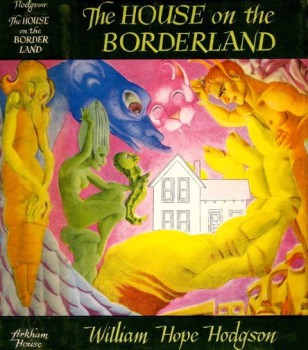 While the exterior, surrounded by overgrown shrubs, was badly in need of paint, and the sagging back porch off the kitchen looked like it might collapse at any moment, there were places inside that also recalled its former or potential beauty. The dining room, in particular, was a room you could step into and imagine you were living in high style — if you blocked out of your head, for the moment, everything that surrounded it. The gleaming hardwood floor, the carved moldings and panels, the beautiful dark-stained hutches filled with china lining the walls — it was all lovely, if you didn’t look too closely and notice how out of straight all the lines were, what with the shifting of the house’s frame over the years. Nothing was quite level or plumb; all was slightly out of alignment.
While the exterior, surrounded by overgrown shrubs, was badly in need of paint, and the sagging back porch off the kitchen looked like it might collapse at any moment, there were places inside that also recalled its former or potential beauty. The dining room, in particular, was a room you could step into and imagine you were living in high style — if you blocked out of your head, for the moment, everything that surrounded it. The gleaming hardwood floor, the carved moldings and panels, the beautiful dark-stained hutches filled with china lining the walls — it was all lovely, if you didn’t look too closely and notice how out of straight all the lines were, what with the shifting of the house’s frame over the years. Nothing was quite level or plumb; all was slightly out of alignment.
As a reader of Lovecraft, it did cross my mind to wonder if there was any non-Euclidean geometry going on. The effect also couldn’t help but bring to mind Hill House, Shirley Jackson’s seminal haunted locale, which Eleanor notes “had an unbelievably faulty design which left it chillingly wrong in all its dimensions, so that the walls seemed always in one direction a fraction longer than the eye could endure, and in another direction a fraction less than the barest possible length.”
As solid as the dining room may have misleadingly appeared at first glance, parts of the house were downright condemnable. Once, when we were carrying a dresser upstairs, a plank at the foot of the staircase gave in. No one was injured, but thereafter there was a small hole that we had to be careful to step over.
Another time, when I was alone one night in the living room watching Ken Burns’ Civil War documentary (I rented the VHS tapes from the Winona library and, over the course of a couple weeks, watched the whole series alone in that drafty room), I got up for some reason to stare out the front window. Perhaps my curiosity was piqued by a passing car, since that would have been unusual — rarely did a soul ever drive by on that road, the farmer’s contention that it was once a stagecoach route notwithstanding. Standing there at the window, I suddenly felt the floorboards beneath me sagging and about to give way. I quickly stepped back, and never ventured to that end of the room again. At that time, I didn’t even know where I would have been deposited had I fallen through — no idea what lay beneath me.
The staircase to the two upstairs bedrooms was a narrow, straight one that ran up between the living room and the master bedroom. It was just outside our bedroom doorway, with a small landing between the two rooms that would have at one time been enclosed on either side by a door (and perhaps I should mention that there were, in fact, no doors on any of the downstairs rooms: the two doors to the master bedroom and even the door to the bathroom had been removed. When I asked the farmer about this once — with regard to the bathroom and privacy issues — he explained that the previous tenant was from some country in Europe where they did not believe in doors, and so at her request he took them out).
At first we thought this staircase was the only one on the main floor. But we were soon to discover a second, “hidden” staircase.
6. The Hidden Room
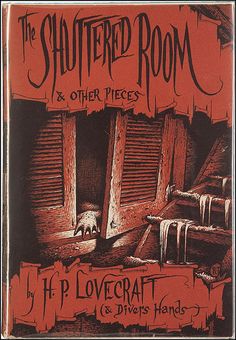 There was a thick, almost black paneled door in the dining room (the one door that had not been taken off its hinges) that would not open — the frame had warped so off kilter that it was jammed. I did not like residing in a place where I didn’t know what was beyond a door I walked by every morning and night, and it ate at me until I decided to pry it open.
There was a thick, almost black paneled door in the dining room (the one door that had not been taken off its hinges) that would not open — the frame had warped so off kilter that it was jammed. I did not like residing in a place where I didn’t know what was beyond a door I walked by every morning and night, and it ate at me until I decided to pry it open.
What the open door revealed was a rickety staircase that ascended to an upstairs room that was not connected to the rest of the upstairs. I tentatively went up the creaking stairs with a flashlight (there were no working lights beyond that door, and no windows). This room obviously had not been opened in a long time — the air was stagnant and thick with stirred-up dust, like we were breaking into a sealed tomb.
The room was cluttered (like any place anywhere on this farm that was not actually part of our living space — I told you, this guy was a hoarder); the only distinct impression I retain is of a small single bed, a child’s bed, in the far corner of the room. The rest was all jumbled shapes and forms and lumps and angles, all smothered in shadows, all draped with cobwebs. It was like I had stepped into a completely different setting, one apart from the house itself — a prototypical horror setting — like that hidden room in the barn in The Ring.
I re-jammed the door, pushed a buffet table in front of it, and never went up there again.
7. The Pantry
Between the kitchen and the dining room was a walk-in pantry, and a door inside this pantry opened on the cellar stairs, about which more later. Before I get to the cellar, there are several other discoveries to catalogue that helped ratchet up the anxiety and suspense that affected my mindset about venturing into the basement.
8. The Demon Room
When we were moving our stuff in from storage, I made my first disturbing discovery right off the bat in an upstairs bedroom. It immediately got my imagination tuning in to the frequency of “horror-movie scenario”…
I had chosen the small upstairs room facing the front yard as my “office.” In two-story houses I’ve always gravitated to an upstairs loft, in keeping with the image of the writer (or the wizard) toiling away up in the “ivory tower” (someday I’d like to have a real tower, like Yeats).
When I first stepped in to the barren, yellow room I encountered a figure staring at me. It was only my own reflection in the mirror of an antique washstand — the sole piece of furniture in the room.
This was in early winter — yes, we were moving in the dead of a Minnesota winter; don’t ask me why. There were many things I did back then that I cannot fathom the reasoning for now. I could see my own breath as I rolled the commode off into a corner. I planned to place my desk where it had been beside the window looking out over the yard. As soon as the section of the wall previously concealed by the mirror was revealed, I was met with a sight so perplexing that it took me a moment to process what I was looking at…
Clustered into a patch about the size of the palm of my hand were flies, dozens of black houseflies. (And if you’re suddenly thinking of the fly scene in that upstairs extra room in The Amityville Horror, or perhaps the fly scene in The Exorcist: Bingo! You’re on the same wavelength as I was.)
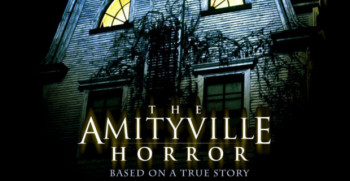 Now, what made the phenomenon I was gaping at so incomprehensible was, again, this was winter. The only flies one might expect to see this time of year should be lying on their backs on an undusted windowsill. On top of that, I’d never seen flies clustered like this in one spot, like they were huddled there for warmth. I ran downstairs and grabbed a flyswatter. Came back up and with one swat took out maybe three or four dozen flies.
Now, what made the phenomenon I was gaping at so incomprehensible was, again, this was winter. The only flies one might expect to see this time of year should be lying on their backs on an undusted windowsill. On top of that, I’d never seen flies clustered like this in one spot, like they were huddled there for warmth. I ran downstairs and grabbed a flyswatter. Came back up and with one swat took out maybe three or four dozen flies.
Having disposed of the icky splotch of fly guts, I was in for a second — even more disturbing — shock. Examining the spot where the flies had amassed, trying to ascertain what had caused them to gather there, I discovered that there were two words carved into the wall.
I strained to read the words — they were quite small, the letters razor-thin — and then reeled backward with a gasp as if struck by a physical blow. I had read “Demon.”
I moved back in, having to know for sure if the house we’d just paid a deposit and first-and-last month’s rent for was some kind of portal to Hell. I was only slightly relieved to see that in my haste I had overlooked an i and misread the final m as an n. What it actually said was “Die Mom.”
So what gives with the flies covering these disconcerting words?
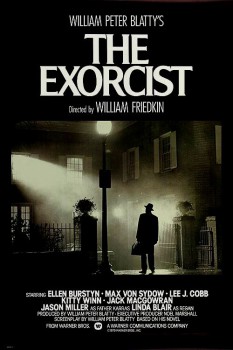 Well…although I do have a lively interest in the supernatural, I am also skeptical by nature and can rattle off a scientific theory as well as the next debunker. A natural explanation: the carving of those letters into the old, yellow wallpaper had exposed glue to which the flies were attracted. When the cold set in, they remained perched there, bundling together for warmth as they slipped into their hibernation state.
Well…although I do have a lively interest in the supernatural, I am also skeptical by nature and can rattle off a scientific theory as well as the next debunker. A natural explanation: the carving of those letters into the old, yellow wallpaper had exposed glue to which the flies were attracted. When the cold set in, they remained perched there, bundling together for warmth as they slipped into their hibernation state.
Convincing enough? Was it good enough to convince me? Not right at the time; I only thought of that explanation in the following days, as I had to reconcile myself to the fact that I was going to be living in this place — which, in the light of day, is fine: but when you have to fall asleep in an old dark house far, far from any city lights (have you seen how pitch black it gets out in the country?), any natural, logical explanation that does not involve the demonic is comforting.
But who carved those words?
At the first opportunity, I tracked down the farmer (he was notoriously hard to get ahold of, coming and going as he did — sometimes we might not see him for days) and asked him about who had lived in the house before us.
Turns out we were only his second tenants. He said his mother had continued to live in the house as an invalid during her final years (The horror-movie imagination was in full gear: Could it have been the farmer himself who’d carved the words, resentful of his lingering matriarch and the care she demanded? Was it part of some occult hex, meant to hasten her parting? …Or might he have done so by more conventional means?). After she died, he decided to move into the trailer next door and rent out the house.
The previous tenants were the European lady (the one who had something against interior doors) and her son. I asked about the son, what he was like (I can’t remember if I told him about the words, specifically — I think I was reticent to bring them up, in case it had been the farmer who’d carved them — wouldn’t want him suspecting I was on to him!). The farmer said the young man did not seem to get along too well with his mother — he’d overheard them fighting a few times, and the boy was a rebellious handful (hard to blame the kid too much, living in this creepy place in the middle of nowhere).
I asked what became of the woman and her son. The farmer shrugged. He didn’t know where they went after they moved out, hadn’t kept in touch with them. Then, with a conspiratorial wink, he mentioned how another of the woman’s “European” traits was that she liked to sunbathe in the nude, to which he did not object.
The farmer departed to attend to whatever was next on his never-ending list of chores. Are you, dear farmer, my horror-movie imagination thought as I watched him walk away carrying a bucket, a serial killer?
Over and against the horror-movie imagination, my more rational mind reassured me that the boy had likely just carved the words with a pocketknife in a fit of pique after his mother had sent him up to his room. But that’s pretty weird, the horror-movie imagination nudged in. Here this young teen has a mother running around naked, and he’s filled with rage at her — there’s some crazy Oedipal shit going on there, boy. And they’re living in this spooky, isolated house where the landlord had taken care of his dying mother? You’ve got some promising parallel structure, some thematic echoes to play around with too!
9. The Neighbor’s Wife
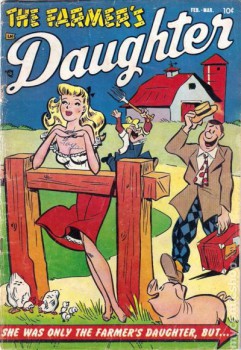 To humanize the farmer a bit, later that year I found out that the couple living on the next farm over was his daughter and son-in-law. Their farm was also part of the family estate, land he had apportioned to them when they’d gotten hitched. And the daughter, a hearty blonde of Scandinavian descent, was gorgeous!
To humanize the farmer a bit, later that year I found out that the couple living on the next farm over was his daughter and son-in-law. Their farm was also part of the family estate, land he had apportioned to them when they’d gotten hitched. And the daughter, a hearty blonde of Scandinavian descent, was gorgeous!
She literally showed up on our doorstep one evening to borrow some sugar or something. I found myself — isolated out there in the cold north with no friends, no social life, 1800 miles from the state where I’d grown up, in a fragile marriage that was going to break in about another two years’ time — well, I found myself fantasizing a little bit. Imagining the woman from the farm down the road visiting again, and not just to borrow a cup of sugar.
But that didn’t happen. She was married; I was married. I think I only saw her a couple times after that, just long enough to exchange brief (and, on my side at least, awkward) pleasantries. Notwithstanding the boring reality, the introduction of a stunning young beauty as the daughter of the farmer (patriarch of the crumbling estate who might not be as innocent as he seems) infused a touch of Gothic romance into the scenario, but just a single note that went nowhere. And it interjected a brief jolt of a variant strain of the imagination — what with the potential set-up of the “dalliance with the farmer’s daughter” motif, popular in folklore — a dash of the erotic imagination. Alas, there was nothing much in subsequent developments to propel that line of narrative, and so the horror-movie imagination held sway.
10. The Photograph
Another in the litany of unsettling discoveries in those first frozen months occurred in the ramshackle lean-to porch on the back of the house. I was poking around out there when I noticed a piece of paper pushed back on the rafter above the entry. I reached up and pulled it down, and found I was staring at the photograph of a dead person.
It was a very old black-and-white picture of an old man laid out for a viewing, his hands crossed over his chest. In other words, a post-mortem photograph or death portrait, which was a more common practice at the beginning of the last century. (Although open-casket viewings are still common, you don’t see too many people standing around snapping pics, even with the ubiquitousness of smart phone cameras in everyone’s pocket.)
Why was this photograph placed here?
I gingerly stuck it back in its place, reasoning to myself that this must be the farmer’s grandfather or great grandfather, the original settler of this land who had built the house. And it was perhaps some strange family tradition that this memento remained here, so that the deathly image of the patriarch could watch every person who entered or exited by the back door. It gave me chills, a little, yet somehow I absorbed it as just another strange feature of this place we now called home, and let it pass.
11. “Quaint and Curious Volumes of Forgotten Lore”
Reinforcing the “maybe there’s more to this farmer than it seems” conjecture was one other discovery that spring. Now that it had warmed up somewhat, I’d ventured into the three-season porch out front and begun poking around. I wasn’t looking for anything in particular.
Nowadays I love searching through antique and vintage junk “picking” for hidden treasures, and while I had some curiosity along those lines back then, it was still rather unfocused. Looking back now, I chide myself for not having explored more thoroughly every room of that house (including the “hidden” bedroom above the secret staircase), not to mention all the packed outbuildings. Not that I would have pilfered anything, but if I uncovered something of interest I would have asked the farmer if it was something he wanted to keep (or even remembered having) and made a modest offer. But on that spring day I wasn’t hunting or picking; I was just seeing if it would be possible to clear enough room that we could use the porch.
I nudged aside a box from which a stack of yellowing, digest-sized magazines spilled out. Picking them up and examining them, I wasn’t quite sure what they were. They appeared to be for some secret society, the Freemasons or some such esoteric group, and seemed to touch on occult matters. What forbidden subjects might you find in the foxed, crumbling pages of these quaint and curious volumes, eh? What forgotten lore?
After cursorily flipping through them, noticing the occasional illustration of a pentagram or thaumaturgic circle, I replaced them in the box, promising myself I would return to them for a more thorough examination later. I never did, and I could not tell you why. It strikes me as strange now — at least as strange as anything else about that place — that my curiosity and my penchant for horror-story material did not draw me back to them. Maybe it was simply that I just never got around to it before the opportunity arose to move in with some new friends we had made who lived in a town about 30 miles away. Perhaps, paradoxically, it was my horror-movie imagination that kept me from going back to that box. There are some things you are not meant to know. That you do not wish to know. That it is probably better not to know.
12. The Vanishing Black Dog
We had a dog when we moved into the farmhouse: a stocky, ferocious-looking black bull of a canine named Bear that was a black lab/Rottweiler/husky mix (he may have had some pit bull in him too; he was an intimidating dog, although possessed of a generally benign personality). We’d gotten him as a pup when we still lived in Arizona; I’m guessing he was around three years old by then. Unfortunately, he didn’t last long out there on the farm. One day he disappeared.
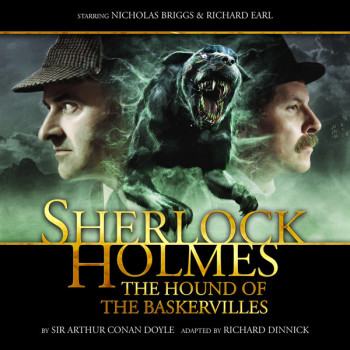 We would let him roam free — he mostly steered clear of the cows, and we were out in the country where no leash ordnance was ever heard of. When we went into the yard and called his name, he was generally pretty good about coming.
We would let him roam free — he mostly steered clear of the cows, and we were out in the country where no leash ordnance was ever heard of. When we went into the yard and called his name, he was generally pretty good about coming.
He never was gone for more than a day, never missed a meal — except for that one time when he returned late, his jaws bloody and reeking of entrails. Oh Bear, what, or who, have you eaten? The farmer happened to be out in his yard on that occasion, and helpfully informed us Bear had gotten into a gut pile. It was hunting season.
Then, not long after that, two days went by without a sign of him, and we started to get worried. With those gut piles deer hunters were dumping all over the countryside, might he have followed his nose from one to the next, being led ever further astray? A lovable but not a terribly bright dog, maybe Bear was one of those mutts not gifted with a great homing instinct.
There were other dangers out there besides hunters: rabid bats and raccoons were not unheard of in the area; there were at least a few cases a year. (Maybe the next time you see Bear, he will be more like Cujo.) And there was one other thought that frightened me: even without the specter of rabies (the irreversible zombie virus of the mammal world), of the dozen or so dogs of varied breeds that I have owned throughout my life, Bear was the one that — were he to “turn” or go “wild” — I wasn’t sure I would be able to reassert mastery over. His veneer of domestication sometimes seemed thin…
He was typically a well-behaved, loyal companion, but I recalled the time at our previous apartment up in Brooklyn Park when I’d taken him for his evening walk across the street to an empty wooded lot. I let him off his leash, and he suddenly went bounding after something. Ignoring my commands, he snatched up a rabbit in his jaws and — snap. The rabbit was dead before it could even make a sound.
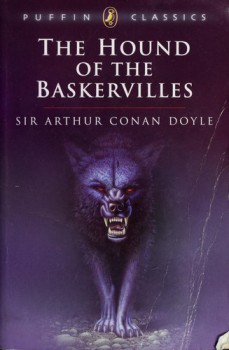 I loved Bear and I think he loved me, but on two distinct occasions I remember looking up from my armchair and the book I was reading to see that massive face staring at me…suspiciously…and felt a twinge of fear, accompanied by the unbidden thought You could kill me right now, couldn’t you. Just lunge up and rip out my throat. I called him over, patted him on the top of his broad head, and reassured myself that he was still this man’s best friend.
I loved Bear and I think he loved me, but on two distinct occasions I remember looking up from my armchair and the book I was reading to see that massive face staring at me…suspiciously…and felt a twinge of fear, accompanied by the unbidden thought You could kill me right now, couldn’t you. Just lunge up and rip out my throat. I called him over, patted him on the top of his broad head, and reassured myself that he was still this man’s best friend.
And now he was gone, vanished out there into the woods.
Days of fruitless searching, driving up and down the rim asking farmers in the area if they’d seen him proved futile, until about a week later when I happened to stop at a farm on the other side of the valley. The fellow said he had seen our dog — a dog matching that description had even come up to his porch and accepted food and water but then had moved on. This had been just a couple days earlier, and it indicated that Bear had somehow gotten far, far afield. We never heard anything more about him.
One local informed us that Bear’s likely fate was to have been taken down by a pack of coyotes.
I shook my head. “Huh-uh, not Bear. He was a tough dog.”
“For one or two coyotes, sure,” the man replied. “But they’ll team up as a pack to take a big dog down.”
My ex-wife was an animal person, so we also had a couple cats, and at some point while living there she even got some chickens — thinking it would be great to have them roaming free range — but they were all done in by an opossum that nested in one of the outbuildings.
13. The Basement
Don’t Look in the Basement.
Let me tell you about the night I did look in the basement.
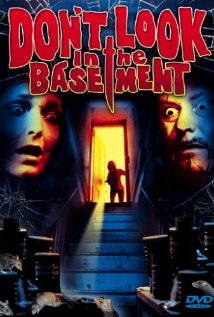 It was strange, those first weeks of living in that house, to think that there were rooms under us — spaces separated just by the buckling (and, in some cases, snapping) floorboards beneath our feet — rooms that we had never seen, the contents of which we could not guess at. (Of course there would be the furnace, the hot water heater — but what else? Perhaps the solution to the mystery of where the former drivers of all those cars went?) I even commented to Joy about it once or twice, vowing that sometime soon I would have to explore the basement just to satisfy my curiosity (or put disquieting fears to rest). But I kept putting it off, and Joy liked to tease me that really I was scared to go down there. Oh, she was a hoot.
It was strange, those first weeks of living in that house, to think that there were rooms under us — spaces separated just by the buckling (and, in some cases, snapping) floorboards beneath our feet — rooms that we had never seen, the contents of which we could not guess at. (Of course there would be the furnace, the hot water heater — but what else? Perhaps the solution to the mystery of where the former drivers of all those cars went?) I even commented to Joy about it once or twice, vowing that sometime soon I would have to explore the basement just to satisfy my curiosity (or put disquieting fears to rest). But I kept putting it off, and Joy liked to tease me that really I was scared to go down there. Oh, she was a hoot.
Then one night, at around 2 or 3 in the morning, Joy woke me. There was a noise coming from the basement. And in that moment, I had to step up and be the “man of the house”; I had to procure a flashlight and instigate a search to determine whether raccoons (or something more insidious) had gotten in, or if the furnace was on the fritz and in danger of blowing up, or who knows what.
I tiptoed into the pantry and opened the rickety door, training my pathetic little sliver of illumination into the pitch black below. Shadows that had lain undisturbed for years seemed to slink back perturbed by the intrusive arrow of light.
The section of the basement I could see was unfinished, like a root cellar. The walls were rough stone; the floor was dirt. The room was lined with floor-to-ceiling shelves made of old planks, and they were stacked with canned jars. All manner of shapes floated inside them, unidentifiable in the inky blackness — human organs?
I screwed up my courage and started down, hoping a wooden step would not crack under me, plunging me down into the gaping maw of darkness. Joy would not come down with me, but she promised she would stay right there by the cellar door — in case I cried out in terror, I guess, or triggered a booby trap. In which case she could get the hell out of there.
I swept my slim torchlight all around the room, but there wasn’t much else to see except jars upon jars, all heavy with dust and cobwebs so thick it was clear no living soul had ventured into this room for years, perhaps decades. I didn’t see anything that could be making the banging and squealing sounds.
Then I spotted another door on the other side of the room. It was closed. So there was another section to the basement, and that’s where the noise was coming from.
I relayed this observation back up to Joy, and then proceeded to unlatch the door and go through into the next, larger room. This part was finished, my slippered feet crossing from rough dirt to cold concrete. This was where the furnace and the hot water heater were located. The noise turned out to be coming from the furnace, I think — I can’t recall now what exactly the issue was or how I fixed it. What I do remember quite clearly (it is forever etched in my mind) is what I saw next…
Pushed up against the wall to my right was a large chest freezer that probably dated back to the 1950s (the kind Leatherface tucks his victims into in The Texas Chainsaw Massacre — in fact, it looked exactly like that). It was plugged in. It was running.
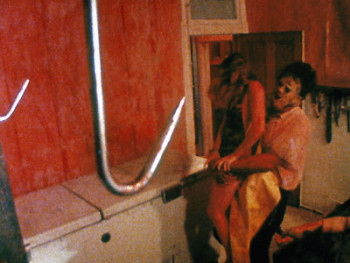 Well. Here we’d lived here for months unaware that there was an old freezer keeping something cold almost directly under our bed. The scenarios the horror-movie imagination had been building up in my mind ever since we moved in reached a crescendo.
Well. Here we’d lived here for months unaware that there was an old freezer keeping something cold almost directly under our bed. The scenarios the horror-movie imagination had been building up in my mind ever since we moved in reached a crescendo.
In that moment, I knew I could not go back upstairs not knowing what was inside that freezer. And another part of me — the horror-movie imagination — knew exactly what I was going to find. It was vetting me, preparing me for it, so that I could make the grisly discovery and neither keel over from a heart attack nor lose my sanity.
And so I walked over. Pried my fingers under the lid. Waited, taking deep breaths. Screwed up my courage yet again. And then yanked it up! What met my gaze was the red patina of flesh! [This is the point where my ex-wife, after I showed her the first draft of this reminiscence, said I screamed. I don’t remember that part.]
…Human flesh?
Its source could not be identified, as it was butchered into cuts of meat. But likely it was beef, given that we were living on the property of a farmer who raised beef cattle.
The mounting climax of horror fizzled away, replaced by growing irritation that this wheezing old freezer (which would definitely not qualify for the Energy Star rating) was running on electricity that we were paying for.
The next day I tromped over to the farmer’s trailer several times until, late in the afternoon, I caught him at home, and I asked him about the freezer. He was getting dressed up for the night, splashing some cologne on his neck.
“Hot date at the townie bar,” he grinned, winking at me.
Standing there in his old trailer — all yellow and orange and ‘70s Formica — as he got gussied up for his date, I felt very much like I had stepped into a David Lynch film.
I diplomatically raised the issue of the freezer and the utility bill, and asked if he wanted to keep the freezer down there and just deduct from the rent the cost to run it.
What he did instead was, a day or two later, run some heavy chains down through the storm doors and wrap them around the freezer, hook the chains up to one of his John Deere tractors, and haul it up and out of there. The freezer and its contents went away.
(Was he hiding something? Was that really just cow meat?)
Afterword
Oh, knock it off, horror-movie imagination. You’ve had your fun. Having rented from the guy for over a year, best as I can tell he was a nice and decent chap. Happy to give us a hand a time or two when the pickup wouldn’t start or got stuck in the snow. A hoarder, I’ll give you that. But as landlords go, I’ve had worse.
I saw the old dark house again, a few years later — on the news. I was single and living in an apartment in Winona by that time. Turns out the current tenants — a mother and her autistic son — had filled the house with 50 or 60 cats, and brought down the wrath of Animal Control on their heads.
I was just thankful that they hadn’t rented the place prior to us. Missing doors you can deal with, but cat urine? Now that’s a horrifying thought.
So, as scary stories go, it was anticlimactic. As far as I can recall, we never did have any overtly supernatural experience in that old dark house – no ghouls or apparitions, just metaphorical phantoms of the past lingering in moldering rooms and moldy photographs. It was the perfect setting for such a tale, and I’m sure elements of it have worked themselves into stories I have written since (populated with the requisite addition of ghosts and monsters). But it would seem the only thing that really haunted that house was me – my own imagination.
That thought brings to mind one night a couple years later. I was walking alone through the old cemetery at the top of the hill above the small town of Lanesboro. There was a full moon, and fog blanketed the ground – ankle-high fog literally rolling across the grass in waves, rising up in rivulets around the weathered granite and marble tombstones – it reminded me (can you guess?) of a scene in any old werewolf film.
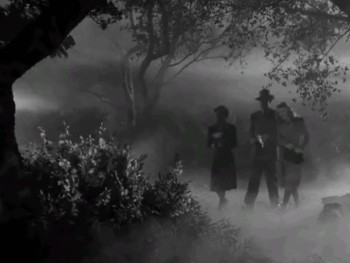 Directly adjacent to this graveyard is a golf course. There is no fence separating the sportive living and the slumbering dead. The eighth hole is not thirty yards from a tombstone – so if your putt goes off the course, you may have to retrieve it from somebody’s grave (a rather odd hazard). There’s an old saying: “A goose just walked over my grave.” If you bought a plot in that cemetery, you could say “A golf ball just rolled over my grave.”
Directly adjacent to this graveyard is a golf course. There is no fence separating the sportive living and the slumbering dead. The eighth hole is not thirty yards from a tombstone – so if your putt goes off the course, you may have to retrieve it from somebody’s grave (a rather odd hazard). There’s an old saying: “A goose just walked over my grave.” If you bought a plot in that cemetery, you could say “A golf ball just rolled over my grave.”
As I neared the greens, I stopped. Looked up at the moon, down at the fog drifting around my ankles, at the silhouettes of the gravestones jutting up all around me like jagged rocks from a roiling river. And I took stock, asking myself: Am I scared?
In that moment I was struck with an odd thought: I am the only ghost in this graveyard tonight.
A soul still clothed in flesh and blood, wandering among the tombs. Telling scary stories. Trying to raise the gooseflesh, yours and my own. To remind us we’re still alive — and we don’t know for how long or what bogeyman will get us in the end — but for now, we are still alive.
“I am the only ghost in this graveyard tonight.”
What a perfect moonlit musing, sir.
Fantastic post. I truly enjoyed reading this.
Was the farmer a killer and the cars his mementos, or did the house drive its occupants to kill? And did Joy really review this for you, or is her car still…parked on that farm? dun, dun, dun!
Cluster flies. They’re a thing in Minnesota.
Eugene R. and Nik Hawkins,
Thank you for reading this longish post, and for your kind words.
Jeff Stehman,
Interesting theory….And what, you might add, really became of the dog and the chickens? dun, dun, dun!
They helped you bury the body, so obviously they had to go.
Understand, I don’t blame you. It’s the house.
Ha!